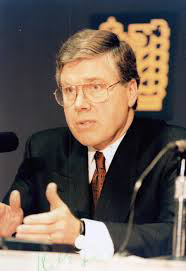
The meeting happened on a November afternoon in 1998. A big merger was in the wind. Rumour of “Yea” or “Nay” ran rampant across the country. One man in the room at a Montreal home argued his industry needed to grow bigger in order to compete globally. The other feared that sector’s customers, Canadian consumers, might not be well served. The industry man got riled.
“You’re not listening to me!” complained John Cleghorn, chairman of the Royal Bank of Canada.

“Mergers … are not in the best interest of Canadians,” said Paul Martin, the MP and cabinet member.
This exchange, described by the Canadian Encyclopedia, recreated the meeting between banker Cleghorn and then finance minister Martin at the latter’s Montreal home.
The two were discussing plans by four of Canada’s five major banks to amalgamate – Royal Bank with Bank of Montreal, and Toronto-Dominion with the Canadian Imperial Bank of Commerce. Martin told Canada’s senior bank executives then that he didn’t think two-mega-banks – controlling 70 per cent of Canadian bank assets – would serve the country’s small businesses, smaller communities or average Canadians.
“History,” Cleghorn said in December 1998, “will judge if Mr. Martin has made the right decision for Canada.”
The financial crisis 10 years later proved Martin absolutely right. Most economists credit the federal government’s resistance to deregulating the industry, not being convinced that bigger is better, and rejecting the amalgamation model as key to economic prosperity, for getting the country through the 2008 financial crisis virtually unscathed.
Martin’s stance on bank mergers came to my mind on Monday, when Ontario-based Rogers Communications unveiled its plan to pay $20 billion to buy Alberta-based Shaw Communications (and another $6 billion to pay out the latter’s debt).
Remarkably, Rogers has presented a similar argument for consolidation that the banks used for merger over 20 years ago. They say amalgamation of Rogers and Shaw will improve nationwide service (especially to under-served areas of the country), accelerate the delivery of the much anticipated 5G network, and create 3,000 jobs in the West.
Why would anybody believe Rogers’ claims? Last November, Rogers laid off a hundred workers in its sports and media business and shut down local media operations in Ontario and the Maritimes. Meanwhile, Bell Media, another of the current Big Four in the Canadian telecom business, showed more than 200 employees in its media division the door less than a month ago.
Even more illustrative of the media giants’ sensitivity to telecommunications jobs, three years ago, when Bell Canada got the green light to purchase Manitoba Telecom Services – not unlike the proposed buy-out of Shaw by Rogers – Bell cut 85 jobs immediately.
“We’ve integrated our operations due to duplication and other roles,” Bell Canada told the CBC in 2018.
The details of Rogers’ plan to gobble up Shaw seem pretty scant right now. But Rogers claims it will dedicate $1 billion to connecting rural, remote and Indigenous communities in Western Canada to high-speed internet, while closing critical connectivity gaps faster for underserved areas.
However, Laura Tribe, a spokeswoman for advocacy group OpenMedia told CBC this week, that fewer providers almost always means higher prices.
“The result is always the same: more profits for the Big Three, worse plans and less choice for Canadians,” Tribe said.
Here’s something else. According to lobby group research, Canada’s major telecom companies have collectively received more than $240 million from the federal government’s wage subsidy program. Meanwhile, they’ve also managed to pay out billions in dividends to shareholders.
Provincial lobby registries report that Bell received $122.9 million, Rogers $82.3 million, and Telus $38.6 million, as part of the Canada Emergency Wage Subsidy. Simultaneously, Bell paid shareholders almost $3 billion in 2020, Rogers just over $1 billion. So, somebody’s getting served. Not, say the lobbyists, those paying for wireless access in Canada.
Those decrying the proposed buyout loudest appear to be those angry about high Internet prices for Canadian consumers. Data from a cable.co.uk survey last year indicate that Canadians paid on average $16.77 for 1GB of wireless data (the global average is $5.09 U.S.) The survey said Canada ranks 209th out of 228 countries when it comes to wireless pricing; the U.S. was 188th (a lower ranking meant a more expensive price).
I guess we can complain. More relevant I think, particularly in the middle of a pandemic when governments have told us for a year now to stay home, work from home, and school from home, is who’s profiting from all this isolation? The wireless telecoms, of course.
Finally, I think former finance minister Paul Martin’s assessment of corporate mergers bears repeating:
“Merger proponents want the mergers to be allowed in order to change the status quo,” he said in 1998. “We believe the status quo must be changed before any merger can be considered.”
You’re absolutely right once again!